Written by Morgan Marks, North-Central and Eastern Montana Field Representative with Montana Wildlife Federation.
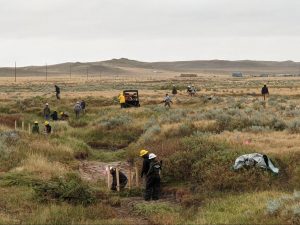
The National Wildlife Federation (NWF) brought partners and diverse organizations together to support the restoration of habitat for Greater Sage-grouse populations this past August as part of a National Fish and Wildlife Foundation (NFWF) three-year grant. 2021 was the final year for the grant and NWF rounded out the work in a good and strong way. In the process of restoring habitat for Greater Sage-grouse, the restoration work also supports the landscape and other wildlife such as other birds and prairie animals.
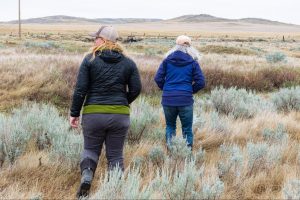
Organizing takes hard work! NWF brought together many dynamic partners for this project, including, the U.S. Bureau of Land Management (BLM), specifically the folks in Montana in the Lewistown and Glasgow offices, Great West Engineering, Montana Conservation Corps (MCC), University of Montana, U.S. Geological Survey, Smithsonian Conservation Biology Institute, Montana Trappers Association (MTA), Defenders of Wildlife, The Nature Conservancy (TNC) and the Montana Wildlife Federation (MWF). All partners were involved in various capacities from supporting the work with on-the-ground people and man-power, project design, site selection, project research, financial support, monitoring, and volunteer recruitment and outreach coordination.

MWF was involved in engaging and recruiting volunteers, supporting the preparation of materials for installation, and working with a few good folks from MTA to provide volunteer coordination and on-the-ground support for the project. The project had multiple people turn out and show up to support on volunteer days, which were purposefully scheduled before installation so that materials could be gathered and ready in advance.
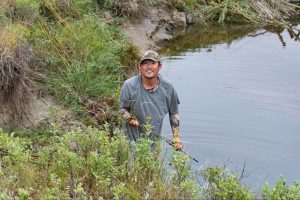
Installation involved BLM staff, Great West Engineering, and Montana Conservation Corps crews to make and install low-tech methods to stall and slow water on the prairie landscape. Volunteers were affiliated with various organizations, such as Montana Trappers Association, Keep it Public, American Prairie Reserve, and the U.S. Forest Service.

Volunteers showed up and worked in very hot and dry conditions, and then the rain came. They cut, hauled, and prepared willows and other woody materials and drove many miles from site to site across Phillips, Valley, and Fergus counties. People carpooled, they camped at BLM campsites in both remote and beautiful locations, and people gave their time in service to the restoration of riparian lands to support the essential species, the Greater Sage-grouse. Volunteers and MWF staff also worked alongside BLM staff to support the removal of old and fallen down fencing on BLM land.


We’re better together. That was the overarching theme of the Greater Sage-grouse riparian restoration project. Conservation should be about working together to support wildlife and habitat, and this project was a shining example of just that. The focus of the location of the projects took place on BLM land. All sites were originally identified and selected as the best options for this project because they were the most viable to experiment with to see if low-tech methods and tree planting would work to restore water to prairie landscapes. Great effort went into understanding the history of the sites and whether or not such methods should be tried.

The prairie is a special place year-round, and especially in late summer, where thunderstorms can roll through, pour rain, and leave the land seemingly unchanged, albeit some thick mud, since Montana has been experiencing drought. In some parts of the state, regions of the state were experiencing drought since the beginning of the year. While the land was mostly bone dry, there were a few pools of water present at multiple sites this past month.
It’s easier to build beaver dam analogs (BDA’s) and log jams when the landscape is wet. When a structure is built in a flowing stream, the results of a BDA and/or log jam are immediate because the water slows down allowing the floodplain to reconnect and reverse the incision in a stream that limits water availability for riparian vegetation. Even with the surprise of rain, everyone shared big smiles during installation, and gratitude was felt for a bit of much-needed moisture. It became a joke that this project “makes it rain” because every year of the three-year cycle, it has rained where the project has taken place. Laughs were shared between people that going forward, activities to re-water the prairie through this grant and the people involved should be known as “the rainmakers.”
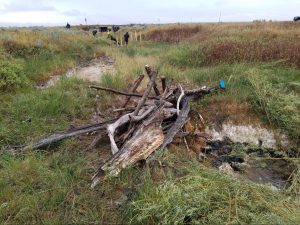
The prairie landscape has changed over time, with the land not keeping and holding water for as long as it once did. The land becomes drier, faster. Prairie streams have changed course, changed the landscape, and erosion has occurred in many areas yielding small, deeply cut streams across prairie landscapes.
Over time natural ways of slowing water down on the land have gone away. For example, beavers are an animal that was typically found in the prairie and on the land, and their dams allowed for water to slow down and pool in places. Without this creature, streams now cut through the land and allow water to rush by with little to stop it or make it stay in one place.
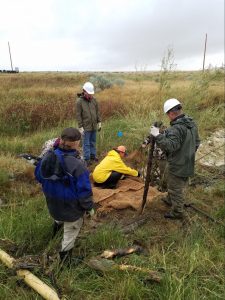
For this three-year project, restoring riparian habitat took many hands and much coordination. It’s important to highlight a few key terms:
Riparian refers to the intersection of land and water along a stream creating habitat and vegetation that depends on access to this intersection and specifically, the access to water; most wildlife and bird species depend on the riparian zone for part of their life cycle.
Restoration refers to work being done to improve, sustain and change the land and existing habitat.
Low-tech methods, which can be referenced in Joe Wheaton’s Riverscapes manual, were used to install structures made of natural materials such as willows and fallen trees, with the intention that the structures would slow the flow of water, and thus, keep water on the land for longer periods of time. Wetter habitat means greener habitat. Greener habitat means that Greater Sage-grouse have places to nest, food to eat and forage, and habitat to support them.
These low-tech methods, in some instances, mimic the work of beavers. Beaver dam analogs or BDA’s are one way to slow water down on the land and literally dam a prairie stream, mimicking the beavers that once were a part of the natural landscape. The goal is to imitate and mimic beavers to restore the land back to its’ natural functioning state, using natural methods and minimal technology. While no land can go back to the way it originally was, these methods will allow the landscape to change to what it can become now – something new, ideally with water staying on the land for longer periods of time to support wildlife and habitat restoration.

Beavers are the natural stewards of the land when it comes to holding water back, and with increased knowledge and people-power, along with many partners working together, these low-tech methods are being tried, tracked, and monitored to see what works on prairie landscapes without beavers being present. Questions have been posed about whether or not the goal is for beavers to exist again in locations where these methods are being tried. The answer is that sometimes beavers make their way back, and sometimes they don’t. The work is about much more than beavers. It’s about learning from nature to strategize about how to best steward the land, and in this case, learning from beavers is one way to positively change prairie landscapes and support the land with riparian restoration.
While the goal of the project was to ultimately support Greater Sage-grouse, as they are a key species on the prairie landscape, it’s important to note that riparian restoration work supports many other species of wildlife, not only sage grouse populations. BLM staff explained how, when they’re looking at the health of the land, they look for Greater Sage-grouse and signs that the bird is on the land and present. The Greater Sage-grouse helps the BLM know how healthy the land is.
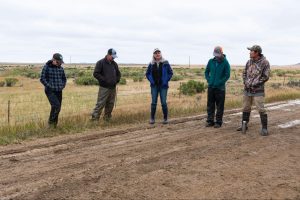
Together, we can support conservation, habitat restoration, wildlife, and public lands.
Together, we can make strides to improve landscapes and support the natural environment.
Together, we are moving forward and creating pathways for positive change to occur – because we’re paying attention to the master, mother nature, and learning as we go.
Readings and Resources to Check Out:
Re-watering the Prairie, Montana stream restoration project imitates beavers to spread water, expand riparian habitat, by Sarah Bates, Acting Regional Executive Director and Senior Director, Western Water, with National Wildlife Federation, Northern Rockies, Prairies and Pacific Region: https://blog.nwf.org/2020/09/re-watering-the-prairie/
Low-Tech Riverscape Restoration Practices Improve Riparian-Wetland Health, by Alden Shallcross, State Lead – Montana/Dakotas Aquatic Habitat Management Program: https://www.blm.gov/blog/2021-02-25/low-tech-riverscape-restoration-practices-improve-riparian-wetland-health
Clark Fork Coalition, Beaver Conflict Resolution: https://clarkfork.org/our-work/what-we-do/restore-the-best/beaver-conflict-resolution

